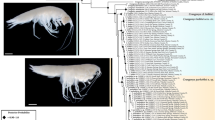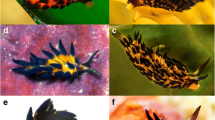Abstract
Within the Pycnogonida, genetic studies have revealed that Colossendeis megalonyx Hoek (Challenger Report, Zoology, 3(X), 1–167, 1881), consists of a complex of several cryptic or overlooked species. Colossendeis megalonyx is a typical Southern Hemisphere species complex distributed primarily on the continental shelves in the Antarctic and Subantarctic. However, a different Colossendeis species with a completely different geographic distribution range, Colossendeis tenera Hilton (Journal of Entomology and Zoology, Pomona College, Claremont, 35(1), 2–4, 1943), was considered a subspecies of Colossendeis megalonyx by Turpaeva (Trudy Instituta Okeanology "P. P. Shirshova", Akademy Nauk SSSR, 103, 230–246, 1975). Colossendeis tenera occurs predominantly along the Pacific Coast of North America from the Bering Sea to central California. Prominent differences between these two currently distinct species are found in body proportions and other characters that were interpreted by Turpaeva as a possible case of pedomorphosis induced by deep-sea conditions. In this study, we tested the hypothesis that Colossendeis tenera belongs to the Colossendeis megalonyx complex by analyzing available and novel sequence data (CO1 and H3) of both Colossendeis megalonyx and Colossendeis tenera as well as a similar, apparently closely related species, Colossendeis angusta Sars (Archiv for Mathematik og Naturvidenskab, 2, 237–271, 1877). We compared morphometric data and SEM of the ovigera of these species. Our results clearly indicate that Colossendeis tenera and Colossendeis angusta are not a part of the Colossendeis megalonyx complex. A sister-group relationship of Colossendeis tenera and Colossendeis angusta is strongly supported, but Colossendeis tenera is not clearly resolved as monophyletic with respect to Colossendeis angusta. This work highlights the need for further examination of the variation found in the tenera-angusta clade. It also gives a first hint of the phylogenetic affinities of species within Colossendeis.




Similar content being viewed by others
References
Appellöf, A. (1912). Invertebrate bottom fauna of the Norwegian Sea and North Atlantic. Ch. 8. In J. Murray & J. Hjort (Eds.), The depths of the sea: 821. London: Macmillan.
Arango, C. P. (2002). Morphological phylogenetics of the sea spiders (Arthropoda: Pycnogonida). Organisms, Diversity and Evolution, 2(2), 107–125.
Arango, C. P., & Wheeler, W. C. (2007). Phylogeny of the sea spiders (Arthropoda, Pycnogonida) based on direct optimization of six loci and morphology. Cladistics, 23, 255–293.
Bamber, R. N. (2007). A holistic re-interpretation of the phylogeny of the Pycnogonida Latreille, 1810 (Arthropoda). Zootaxa, 1668, 295–312.
Bamber, R.N., & El Nagar, A. (Eds.) (2012). Pycnobase: World Pycnogonida Database. Available online at http://www.marinespecies.org/pycnobase/ accessed on 2012-06-08
Bamber, R. N., & Thurston, M. H. (1995). The deep-water pycnogonids (Arthropoda: Pycnogonida) of the northeastern Atlantic Ocean. Zoological Journal of the Linnean Society (London), 115, 117–162.
Calman, W. T. (1915) British Antarctic (“Terra Nova”) Expedition, 1910. Natural History Reports. Zoology, 3(1), 1–74.
Calman, W. T., & Gordon, I. (1933). A dodecapodous pycnogonid. Proceedings of the Royal Society of London (B), 113, 107–115.
Cano, E., & López González, P. J. (2007). Colossendeis species (Pycnogonida: Colossendeidae) collected during the Italica XIX cruise to Victoria Land (Antarctica), with remarks on some taxonomic characters of the ovigers. Scientia Marina, 71(4), 661–681.
Child, C. A. (1994). Deep-sea Pycnogonida from the temperate west coast of the United States. Smithsonian Contributions to Zoology, 556, I–III. 1-23.
Child, C. A. (1995). Pycnogonida of the Western Pacific Islands, XI: Collections from the Aleutians and other Bering Sea Islands, Alaska. Smithsonian Contributions to Zoology, 569, I–IV + 1–30.
Clark, W. C., & Carpenter, A. (1977). Swimming behaviour in a pycnogonid. New Zealand Journal of Marine and Freshwater Research, 11(3), 613–615.
Dietz, L., Mayer, C., Arango, C. P., & Leese, F. (2011). The mitochondrial genome of Colossendeis megalonyx supports a basal position of Colossendeidae within the Pycnogonida. Molecular Phylogenetics and Evolution, 58(3), 553–558.
Diz, A. P., Páez de la Cadena, M., & Rolán-Alvarez, E. (2012) Proteomic evidence of a paedomorphic evolutionary process within a marine snail species: a strategy for adapting to extreme ecological conditions? Journal of Evolutionary Biology, 25, 2569–2581.
Eights, J. (1835). Description of a new animal belonging to the Arachnida of Latreille; discovered in the sea along the shores of the New Shetland Islands. Boston Journal of Natural History, 1(2), 203–206.
Fage, L. (1956). Pycnogonides (exc. le genre Nymphon). Galathea Report, 2, 167–182.
Fry, W. G. (1978). A classification within the pycnogonids. Zoological Journal of the Linnean Society (London), 63(1/2), 35–58.
Fry, W. G., & Hedgpeth, J. W. (1969). The fauna of the Ross Sea. Part 7. Pycnogonida, 1: Colossendeidae, Pycnogonidae, Endeidae, Ammotheidae. New Zealand Department of Science and Industrial Research Bulletin, 198, 1–139.
Gordon, I. (1944). Pycnogonida. British and New Zealand Antarctic Research Expedition 1929-1931. Reports (B = Zoology & Botany), 5(1), 1–72.
Griffiths, H. J., Arango, C. P., Munilla, T., & McInnes, S. J. (2011). Biodiversity and biogeography of Southern Ocean pycnogonids. Ecography, 34(4), 616–627.
Hedgpeth, J. W. (1943). On a new species of pycnogonid from the North Pacific. Journal of the Washington Academy of Sciences, 33(7), 223–224.
Hedgpeth, J. W. (1947). On the evolutionary significance of the Pycnogonida. Smithsonian Miscellaneous Collections, 106(18), 1–53. Pl. 1.
Hedgpeth, J. W. (1949). Report on the Pycnogonida collected by the Albatross in Japanese Waters in 1900 and 1906. Proceedings of the United States National Museum, 98, 233–321.
Hilton, W. A. (1943). Pycnogonida from the Pacific. Family Colossendeidae. Journal of Entomology and Zoology, Pomona College, Claremont, 35(1), 2–4.
Hodgson, T. V. (1907). Pycnogonida. Natural History Collections of the "Discovery" National Antarctic Expedition, Zoology. London, 3, 1–72. Pls. 1–10.
Hoek, P. P. C. (1881). Report on the Pycnogonida, dredged by H. M. S. "Challenger" 1873/76. Challenger Report, Zoology, 3(X), 1–167. Pls I-XXI.
Huelsenbeck, J. P., & Ronquist, F. (2001). MRBAYES: Bayesian inference of phylogenetic trees. Bioinformatics, 17, 754–755.
Jarzynsky, T. (1870). Praemissus catalogus Pycnogonidarum, inventarum in mari Glaciali, ad oras Lapponiae rossicae et in mari Albo, anno 1869 et 1870. Annales de la Société des Naturalistes de St. Pétersbourg, 1, 319–320.
Krabbe, K., Leese, F., Mayer, C., Tollrian, R., & Held, C. (2010). Cryptic mitochondrial lineages in the widespread pycnogonid Colossendeis megalonyx Hoek, 1881 from Antarctic and Subantarctic waters. Polar Biology, 33, 281–292.
Meinert, F. (1899). Pycnogonida. Copenhagen.
Meusemann, K., von Reumont, B. M., Simon, S., Roeding, F., Strauss, S., Kück, P., et al. (2010). A phylogenomic approach to resolve the arthropod tree of life. Molecular Biology and Evolution, 27(11), 2451–2464.
Minnaard, V. A., & Zamponi, M. O. (1984). Estudios sistemáticos de algunos pantopodos de la región subantártica. Historia Natural, 4, 257–279.
Möbius, K. (1902). Die Pantopoden der deutschen Tiefsee-Expedition 1898-1899. Wissenschaftliche Ergebnisse der Deutschen Tiefsee-Expedition auf "Valdivia" 1898-1899. Jena, 3(6), 175–196. Tafeln 24-30.
Munilla León, T. (1999). Evolución y filogenia de los picnogónidos. Boletín de la Sociedad Entomológica Aragonesa, 26, 273–279.
Munilla, T., & Soler-Membrives, A. (2009). Check-list of the pycnogonids from Antarctic and sub-Antarctic waters: zoogeographic implications. Antarctic Science, 21, 1–13.
Nakamura, K., & Child, C. A. (1983). Shallow-Water Pycnogonida from the Izu Peninsula, Japan. Smithsonian Contributions to Zoology, 386, 1–71.
Nakamura, K., & Child, C. A. (1991). Pycnogonida from Waters adjacent to Japan. Smithsonian Contributions to Zoology, 512, 1–74.
Nylander, J. A. A. (2004). MrModeltest v2. Program distributed by the author. Evolutionary Biology Centre, Uppsala University.
Pawlowski, J., Fahrni, J., Lecroq, B., Longet, D., Cornelius, N., Excoffier, L., et al. (2007). Bipolar gene flow in deep-sea benthic foraminifera. Molecular Ecology, 16(19), 4089–4096.
Regier, J. C., Shultz, J. W., Zwick, A., Hussey, A., Ball, B., Wetzer, R., et al. (2010). Arthropod relationships revealed by phylogenomic analysis of nuclear protein-coding sequences. Nature, 463, 1079–1083.
Sars, G. O. (1877). Prodromus descriptionis crustaceorum et pycnogonidarum, quae in expeditione norvegica anno 1876, observavit. Archiv for Mathematik og Naturvidenskab, 2, 237–271.
Sars, G. O. (1891). Pycnogonida. The Norwegian North-Atlantic Expedition 1876/78. Christiania: Grøndahl & Søns.
Schimkewitsch, W. (1893). Compte-rendu sur les Pantopodes. In Reports on the dredging operations off the west coast of Central America to the Galapagos, to the west coast of Mexico, and in the Gulf of California, in charge of Alexander Agassiz, carried on by the U. S. Fish Commission Steamer "Albatross", during 1891, Lieut. Commander Z. L. Tanner, U. S. N., commanding. Bulletin of the Museum of Comparative Zoology, Harvard College 25(2), 27-43. Pls. 1-2.
Stamatakis, A. (2006). RAxML–VI–HPC: maximum likelihood–based phylogenetic analyses with thousands of taxa and mixed models. Bioinformatics, 22, 2688–2690.
Stock, J. H. (1963). South African deep-sea Pycnogonida, with descriptions of new species. Annals of the South African Museum, 46(12), 321–340.
Strugnell, J., Rogers, A. D., Prodöhl, P. A., Collins, M. A., & Allcock, A. L. (2008). The thermohaline expressway: the Southern Ocean as a centre of origin for deep-sea octopuses. Cladistics, 24, 853–860.
Turpaeva, E. F. (1975). On some deep-water pantopods (Pycnogonida) collected in north-western and south-eastern Pacific. Trudy Instituta Okeanology "P. P. Shirshova", Akademy Nauk SSSR, 103, 230–246. In Russian.
Turpaeva, E. F. (1996). Variability of sea spiders morphological characters (Pycnogonida) related to their habitat depth. Okeanologiya, 36(6), 892–896. In Russian.
Wilson, E. B. (1881). XIII. Report on the Pycnogonida. In Reports on the Results of Dredging, under the Supervision of Alexander Agassiz, along the coast of the United States, during the summer of 1880, by the U. S. Coast Survey Steamer "Blake“, Commander J. R. Bartlett, U. S. N., Commanding. Bulletin of the Museum of Comparative Zoology, 239-256. Pls. I- V.
Wood-Mason, J. (1873). On Rhopalorhynchus Kröyeri, a new genus and species of Pycnogonida. Journal of the Asiatic Society Bengal, 42(9), 171–175. Tab. 13.
Acknowledgements
We would like to thank Anja Friederichs (Museum für Naturkunde Berlin) for taking additional photographs of the Mexican C. tenera specimen, Hieronymus Dastych (Zoologisches Museum Universität Hamburg) for providing the samples of C. angusta, Anna Soler i Membrives for information on the C. angusta sequence data in GenBank, Saskia Brix and the organizers of the ICEAGE cruise for C. angusta, and Meike Seefeldt for the SEM photographs of C. angusta. We also thank Yoshie Takahashi for information on Colossendeis species from Japan. Furthermore, we would like to thank Christoph Held, Christoph Mayer, Markus Gronwald, and Ralph Tollrian for support and helpful discussions, and three anonymous reviewers for comments that were a great help in improving the manuscript. This work was funded by DFG grant LE 2323/2 to FL within the priority programme, SPP 1158.
Ethical standards
The experiments comply with the current laws of the country in which they were performed.
Conflict of interest
The authors declare that they have no conflict of interest.
Author information
Authors and Affiliations
Corresponding author
Electronic supplementary material
Below is the link to the electronic supplementary material.
Online Resource 1
Sequence data used (DOC 96 kb)
Online Resource 2
Concatenated ML tree of 16S, 12S, CO1, and H3. Within the Colossendeis megalonyx clade several species with an “*” are those that were downloaded from GenBank. (PDF 30 kb)
Online Resource 3
(a) Information on the eigenvalues of the ten calculated factors and the total variance. (b) Factor loadings indicating correlations with the different variables. Factors 1 and 2 were visualized in the PCA. (PDF 314 kb)
Online Resource 4
Morphological measurements for all individuals of C. tenera, C. angusta, and C. megalonyx specimens, including both our own measurements and those from the literature (lengths relative to trunk are shown if not listed otherwise). (DOC 181 kb)
Rights and permissions
About this article
Cite this article
Dietz, L., Krapp, F., Hendrickx, M.E. et al. Evidence from morphological and genetic data confirms that Colossendeis tenera Hilton, 1943 (Arthropoda: Pycnogonida), does not belong to the Colossendeis megalonyx Hoek, 1881 complex. Org Divers Evol 13, 151–162 (2013). https://doi.org/10.1007/s13127-012-0120-4
Received:
Accepted:
Published:
Issue Date:
DOI: https://doi.org/10.1007/s13127-012-0120-4




